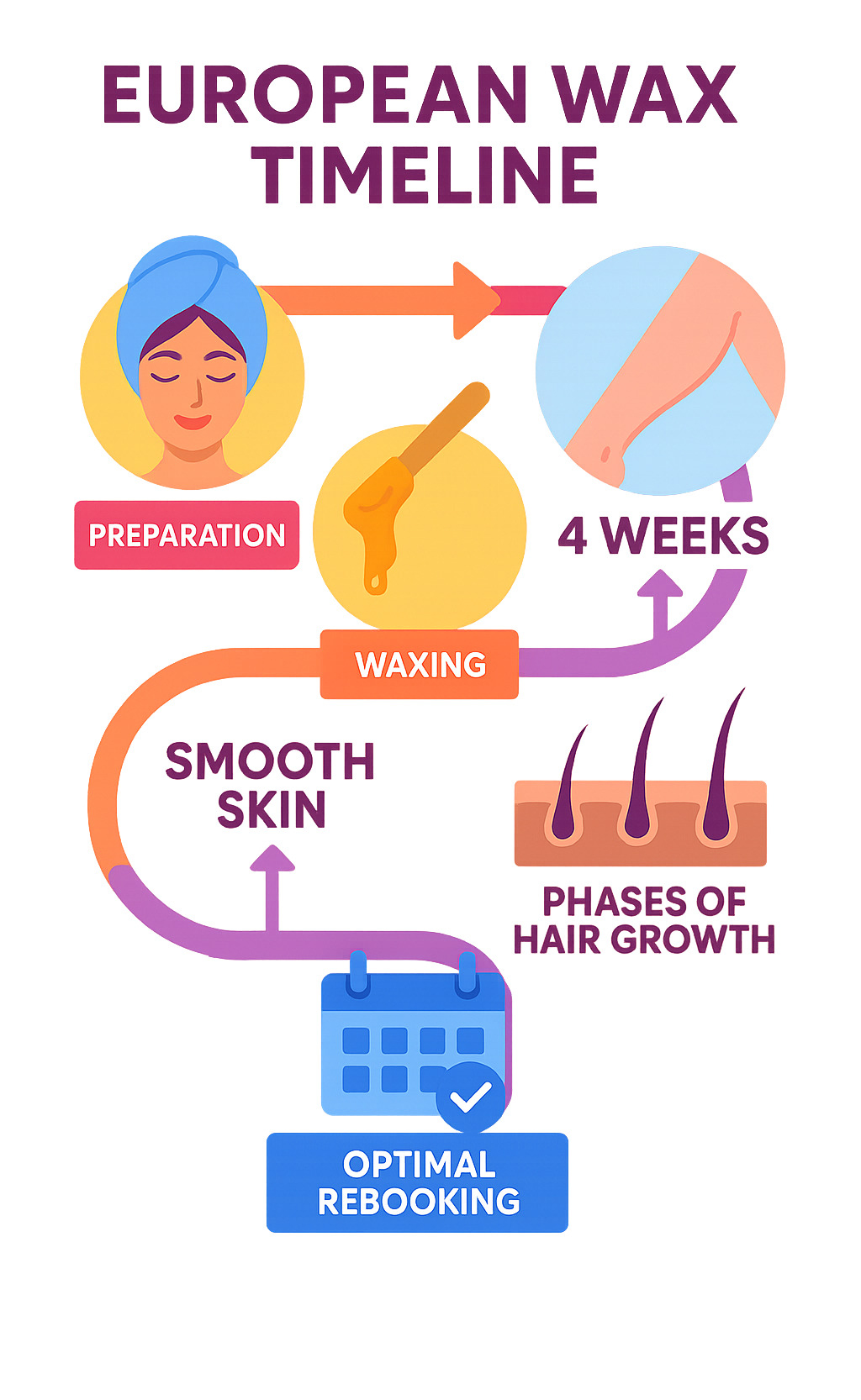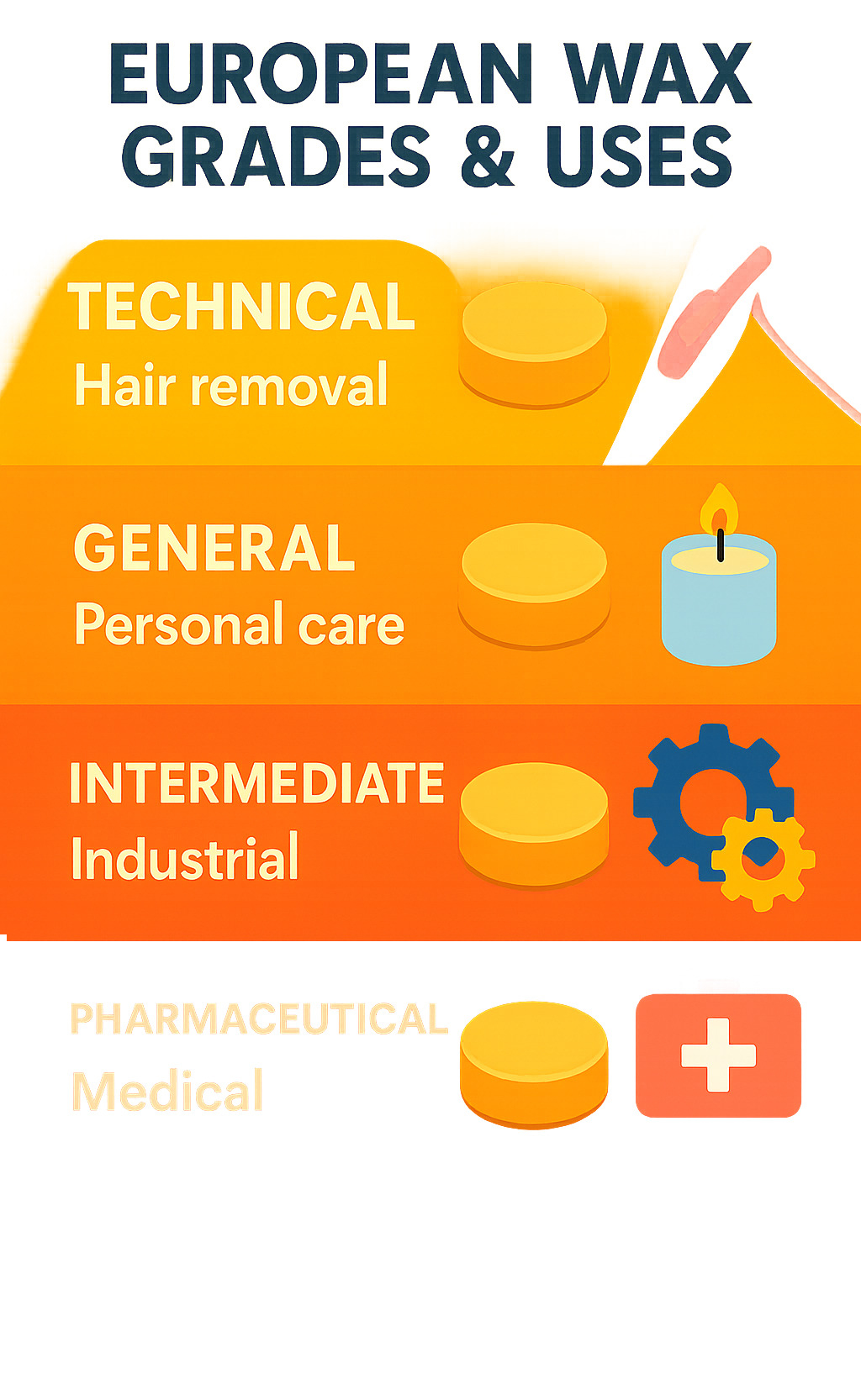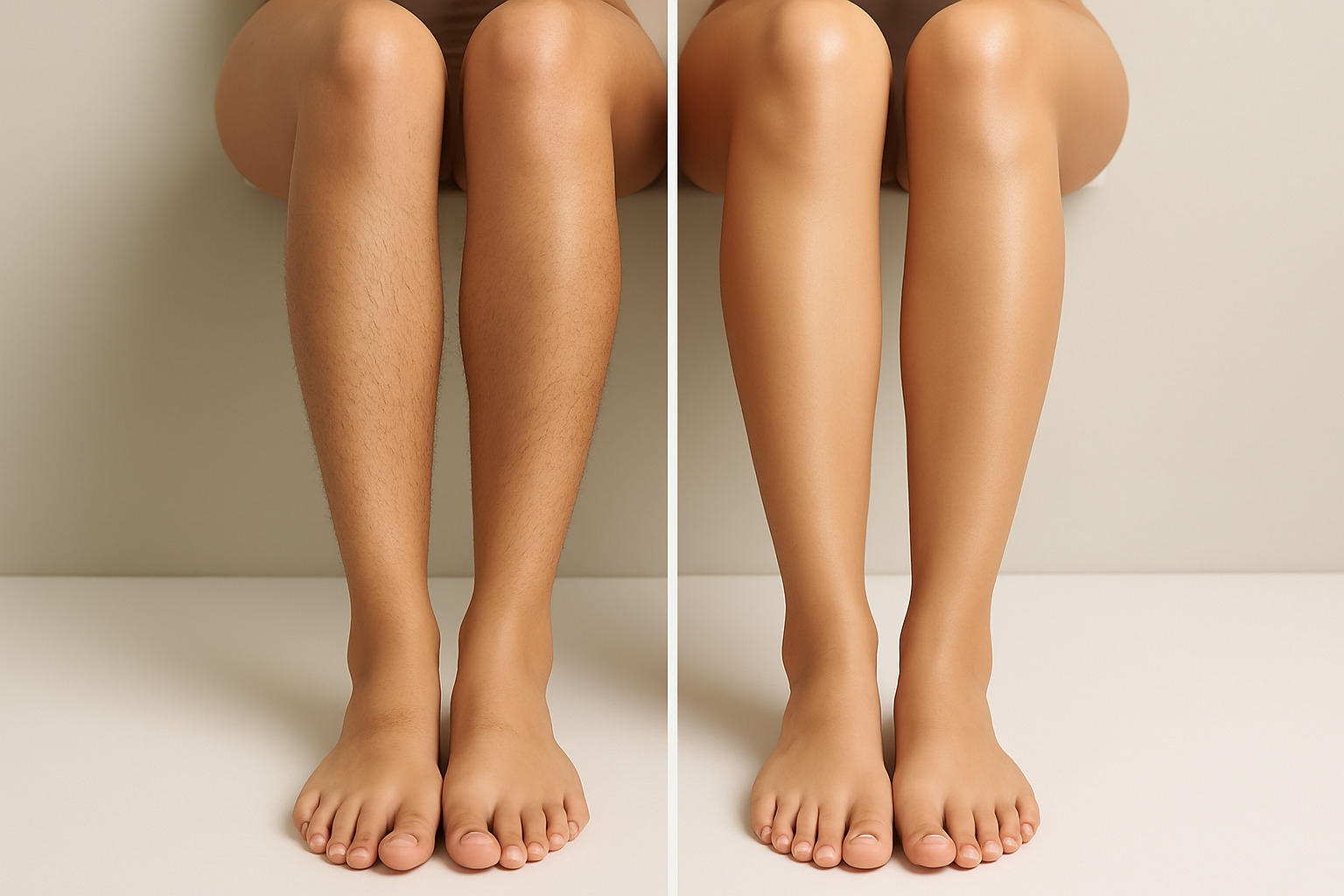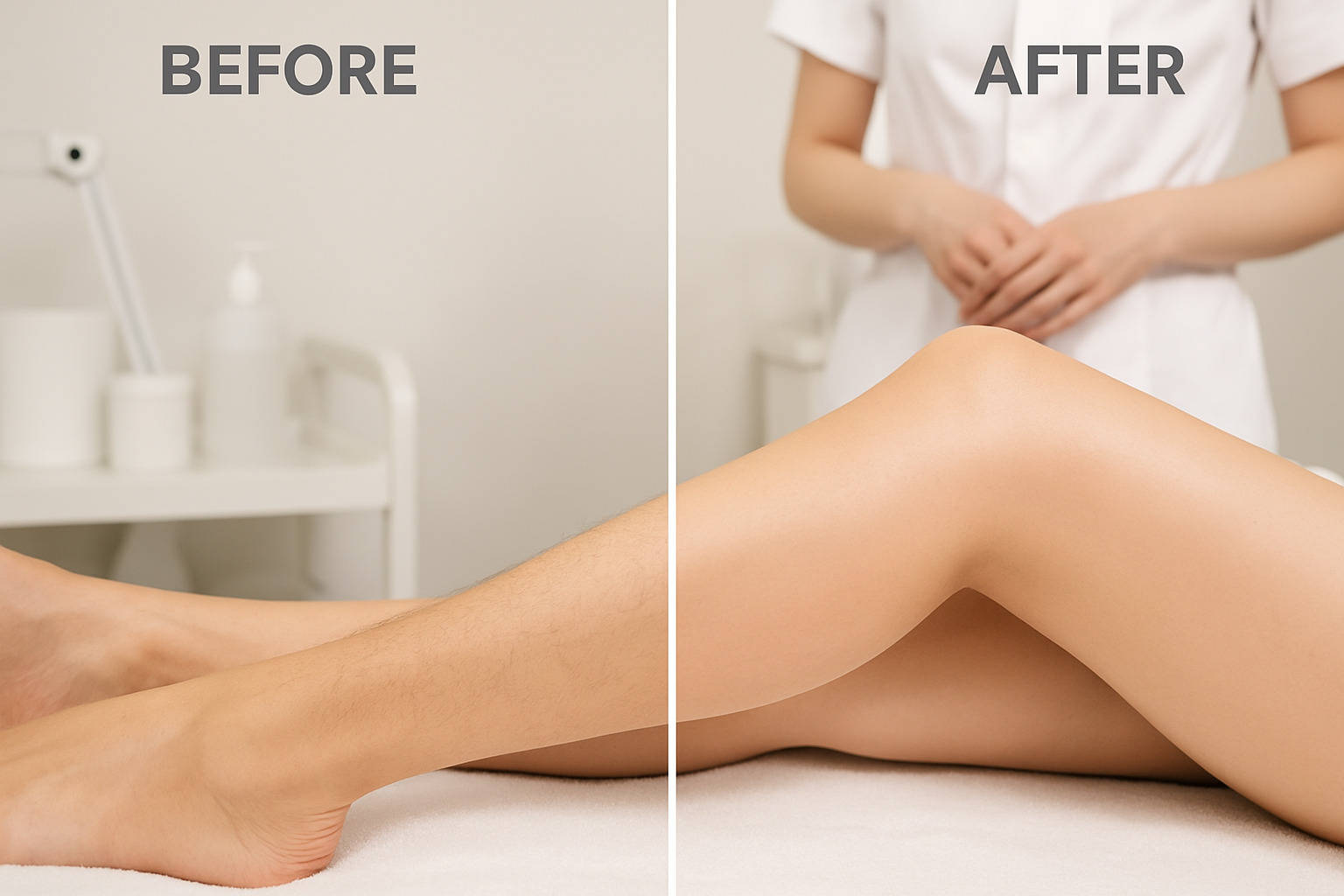Why European Wax is Changing Hair Removal
European wax has become the gold standard for professional hair removal, offering superior results compared to traditional waxing methods. Here’s what makes it special:
Key Benefits of European Wax:
- Gentler formula – Lower melting point reduces skin irritation
- Longer-lasting results – Hair stays gone 3-4 weeks for body, 2-3 weeks for face
- Finer regrowth – Hair grows back thinner and softer over time
- Fewer ingrown hairs – Professional-grade resins minimize skin trauma
- Versatile application – Works on all body areas and hair types
The secret lies in the specialized formula. European wax blends premium beeswax with high-quality resins that melt at lower temperatures. This means less heat on your skin and better hair removal with each pull.
As one long-time client shared: “I worked at Nordstrom in college, and while retail was brutal, chatting with the other girls on the floor shaped my beauty routine—one rave about European Wax Center changed everything.”
With over 800 European Wax Center locations nationwide and most services taking less than 20 minutes, this method has proven its effectiveness. The four-step process (cleanse, protect, wax, refresh) ensures consistent results.
Unlike shaving that lasts just days, European wax removes hair from the root. This means smoother skin for weeks, not hours. Plus, regular waxing actually trains your hair to grow back finer and sparser over time.

Quick look at european wax:
European Wax 101 – What Makes It Different?
Think of European wax as the luxury car of hair removal products. While regular wax gets the job done, European wax does it with style, comfort, and superior results.
The magic starts with the unique formula. European wax combines premium beeswax with specialized resins, creating something truly special. The lower melting point means the wax doesn’t need to be as hot to work effectively, which translates to a more comfortable experience for your skin.
Picture this: instead of scalding hot wax that makes you grip the treatment table, European wax works at a gentler temperature while still adhering better to hair. It’s like having your cake and eating it too – better results with less discomfort.
You’ll encounter two main types when you visit a professional salon. Strip wax (sometimes called soft wax) goes on thin and comes off with cloth strips, making it perfect for larger areas like your legs. Hard wax is applied thicker and hardens enough to be removed without strips – ideal for sensitive spots like your bikini area where precision matters.
The salon standards for European wax are notably stricter than typical waxing products. Professional-grade formulations must pass rigorous quality controls for consistency, purity, and performance.
Benefits of European Wax versus Shaving
Let’s be honest – we’ve all been there with a razor, trying to get that perfect smooth finish only to find stubble the next day. European wax changes this entire frustrating cycle.
Thinner regrowth is perhaps the most exciting benefit. When you shave, you’re essentially giving your hair a blunt haircut at skin level. This makes regrowth feel coarser and more noticeable. European wax removes hair from the root, and here’s the beautiful part – it actually damages the hair follicle slightly each time. Over months of consistent waxing, your hair grows back progressively thinner and finer.
Say goodbye to the ingrown hair nightmare. Shaving creates sharp, stubby ends that love to curl back into your skin, causing those painful bumps we all dread. European wax removes the entire hair shaft, so when it does grow back, it emerges with a natural, tapered point that’s much less likely to cause problems.
The longer-lasting results speak for themselves. While your razor gives you maybe two days of smoothness, European wax keeps you hair-free for 3-4 weeks on your body and 2-3 weeks on facial areas.
Scientific research on waxing and hair regrowth backs up what we see in practice – regular waxing can actually reduce hair density over time, making each session easier and more comfortable than the last.
Diverse European Wax Varieties & Uses
European wax is surprisingly versatile, and understanding its various applications helps explain why it’s so effective for hair removal.
In personal care, European wax is carefully formulated for different needs. Facial waxes are gentler and designed specifically for sensitive skin, while body waxes are formulated to tackle coarser hair effectively.
Beyond hair removal, European wax finds its way into candles and industrial applications. The same quality standards that make these waxes safe for industrial use ensure they’re pure and effective for your skin.

The ethical sourcing aspect adds another layer of quality. Premium beeswax often comes from suppliers who support bee conservation and community development. This means your smooth skin comes with the bonus of supporting sustainable practices.
Preparing & Experiencing Your First European Wax Session
Let’s be real – the thought of your first European wax appointment can feel a bit nerve-wracking. But here’s the thing: with the right preparation and knowing what to expect, most of our clients walk out saying “That wasn’t nearly as bad as I thought it would be!”
The beauty of European wax is in its efficiency. Most appointments wrap up in about 20 minutes, thanks to the superior formula that grips hair better and the skilled professionals who’ve mastered the four-step process.
Here’s something crucial that can make or break your experience: hair length matters. Your hair should be about one-fourth of an inch long – think the size of a grain of rice. Too short and the wax won’t have anything to grab onto. Too long and it’s going to be more uncomfortable than it needs to be.

Now, let’s talk about the elephant in the room – does it hurt? Most clients describe it as a quick, sharp sensation followed by immediate relief. The pain scale varies from person to person and depends on the area being treated, but the lower melting point of European wax makes it genuinely less traumatic to your skin.
| Method | Duration | Pain Level | Results Last |
|---|---|---|---|
| European Wax | 20 minutes | Moderate, quick | 3-4 weeks |
| Shaving | 10 minutes | Minimal | 1-2 days |
| Sugaring | 30 minutes | Moderate | 2-3 weeks |
How to Prepare for a European Wax
Think of prep work as your secret weapon for a smooth European wax experience. Start planning 24-48 hours before your appointment.
Gentle exfoliation is your first step. About two days before your appointment, use a mild scrub or exfoliating mitt to slough off dead skin cells. This helps prevent ingrown hairs and lets the wax grab your hair more effectively. Just don’t go overboard – harsh scrubs can irritate your skin. If you’re dealing with razor burn from your last shave, our Natural Remedy for Razor Burn on Legs guide has some great soothing tips.
On the day of your appointment, skip the lotions, oils, and deodorants on the area you’re getting waxed. These products create a slippery barrier that prevents the wax from gripping your hair properly.
Staying hydrated actually makes waxing more comfortable. When you’re well-hydrated, your skin is more supple and resilient. Drink plenty of water in the days leading up to your appointment.
If you’re worried about pain, consider taking an over-the-counter pain reliever about 30 minutes before your appointment. Just avoid alcohol, which can actually increase skin sensitivity.
What to Expect During Your European Wax Appointment
Walking into your European wax appointment, you’ll start with a friendly consultation. Your specialist will explain the process, ask about any skin sensitivities, and answer any last-minute questions.
The four-step process is beautifully standardized. First, they’ll cleanse the area to remove any oils or bacteria. Next comes protection – a pre-wax oil or powder that shields your skin. Then the actual waxing happens, where the magic of European wax’s superior formula really shines. Finally, they’ll refresh your skin with a soothing serum.
Your specialist’s technique makes all the difference in your comfort level. Professional estheticians apply wax in the direction of hair growth and remove it quickly in the opposite direction. They’ll also hold your skin taut, which significantly reduces discomfort.
The whole process typically takes around 20 minutes for most body areas, though it can vary depending on the size of the area and how much hair you have.
European Wax Pain-Management Hacks
Let’s not sugarcoat it – European wax involves some discomfort. But it doesn’t have to be the torture session you might be imagining.
Deep breathing is your secret weapon. Take a deep breath before each strip comes off, then exhale as it’s removed. This simple technique relaxes your muscles and can cut your perceived pain in half.
Distraction techniques work like magic. Bring headphones for music or a podcast, or chat with your specialist about weekend plans. When your brain is busy processing other information, it has less bandwidth to focus on momentary discomfort.
Ask about topical cooling options. Many specialists use cooling gels or sprays that slightly numb the area before waxing and soothe skin afterward.
Here’s the best long-term strategy: stick to a consistent schedule. When you wax every 3-4 weeks, you’re always removing finer, shorter hair that’s much less uncomfortable to remove. Regular waxing is actually the kindest approach to your skin and your comfort level.
Aftercare, Results & Long-Term Benefits
Your European wax journey doesn’t end when you leave the salon – proper aftercare is what transforms a good wax into amazing, long-lasting results. Think of the first 24 hours as your skin’s recovery period, when a little extra care goes a long way.
The 24-hour rule isn’t just a suggestion – it’s your roadmap to avoiding irritation and getting the most from your wax. Your hair follicles are temporarily open after waxing, making them more vulnerable to bacteria and irritation. This means avoiding heat (hot showers, saunas, direct sunlight), skipping activities that cause excessive sweating (intense workouts, hot yoga), and staying out of water (pools, baths, hot tubs) for that first day.
Once you’ve made it through those crucial first 24 hours, your skin is ready for the next phase of care. Gentle exfoliation becomes your secret weapon against ingrown hairs, but timing matters. Wait at least 48 hours post-wax before you start exfoliating – your skin needs that time to fully recover from the waxing process.
Here’s where the science gets interesting: hair grows in three distinct phases called anagen (active growth), catagen (transitional), and telogen (resting). Since not all your hairs are marching to the same beat, it takes several European wax sessions to get them synchronized. This is why your results keep getting better with each appointment.
The long-term benefits are where European wax really shines. Clients who stick with regular waxing often tell us their hair becomes so fine and sparse that they can stretch their appointments from every 4 weeks to every 6 weeks or even longer. Your hair follicles actually weaken over time, leading to finer regrowth and skin brightening as dead skin cells are regularly removed.

Immediate Aftercare Essentials
Right after your European wax, your skin is in healing mode and deserves some gentle TLC. If you notice any redness or sensitivity, don’t panic – this is completely normal and usually fades within a few hours.
A cool compress is your first line of defense against any post-wax sensitivity. Simply wrap some ice in a soft cloth or use a cold, damp towel for instant relief. The cooling sensation helps calm irritated skin and reduces any inflammation.
Soothing gels are like a spa treatment for freshly waxed skin. Look for products with aloe vera, chamomile, or tea tree oil – these natural ingredients are gentle yet effective at preventing irritation. Many professional waxing centers offer specialized post-wax serums designed specifically for this purpose.
Your clothing choices matter more than you might think in the first 24-48 hours. Loose-fitting clothes in breathable fabrics like cotton prevent friction against sensitive skin and help avoid those pesky ingrown hairs that can develop from tight clothing rubbing against new hair growth.
If you’re interested in creating your own natural aftercare treatments, our guide to DIY Natural Beauty Tips offers homemade soothing solutions that work beautifully alongside professional aftercare products.
Long-Term Results & Waxing Cadence
The real magic of European wax unfolds over time, and most clients start seeing those “wow” results after their third or fourth session. This is when hair growth begins to synchronize and you’ll notice hair becoming visibly finer and easier to remove.
Body areas typically need attention every 3-4 weeks, while facial areas usually require appointments every 2-3 weeks due to faster hair growth cycles on the face. But here’s the exciting part – as your hair becomes finer and sparser with regular waxing, many clients find they can extend these intervals significantly.
The cost efficiency of European wax becomes clear when you look at the bigger picture. Yes, the upfront cost is higher than buying razors, but the long-lasting results and reduced frequency of treatments make it economical over time. Plus, think about all the time you’ll save not having to shave every few days.
Hair growth reduction is one of the most celebrated long-term benefits we hear about from clients. Many report up to 50% reduction in hair density after maintaining regular waxing for about a year. This isn’t just wishful thinking – the repeated removal process actually weakens hair follicles over time, leading to permanently reduced hair growth.
The journey with European wax is truly cumulative – each session builds on the last, creating smoother, more confident you along the way.
Products, Safety & Sustainability in European Waxing
The world of professional European wax extends far beyond your appointment time. Think of it as a complete ecosystem of products and practices designed to give you the smoothest, safest experience possible.
Aftercare serums are the unsung heroes of great waxing results. These specially formulated products contain soothing ingredients that calm irritation and prevent those pesky ingrown hairs that can pop up between appointments.
Exfoliating pads designed for post-wax care walk a fine line – they need to be gentle enough for sensitive skin but effective enough to keep follicles clear. These products typically contain mild acids like glycolic or salicylic acid that do the heavy lifting without causing irritation.
For those with sensitive skin, hypoallergenic formulas are non-negotiable. Professional European wax products skip the common troublemakers like fragrances, dyes, and harsh chemicals that could turn your smooth skin dreams into a red, irritated nightmare.
Patch testing should always be your first step, especially if you’re new to waxing or have known skin sensitivities. A small test area today can save you from a full-body reaction tomorrow.
Recommended Pre- & Post-Wax Products
Let’s talk about the products that can make or break your European wax experience. Ingrown hair serums are absolute game-changers – we’re talking about products with 4.6 out of 5-star ratings from clients who’ve experienced the difference firsthand. These serums blend salicylic acid, glycolic acid, and soothing botanicals to prevent and treat ingrown hairs effectively.
Gentle scrubs formulated specifically for post-wax skin are worth their weight in gold. The key is finding products with fine, rounded exfoliating particles rather than harsh, jagged scrubs that can damage your newly sensitive skin.
Mineral SPF protection becomes crucial after waxing, especially for facial areas. Freshly waxed skin is more susceptible to sun damage and in need of extra protection. Choose mineral sunscreens with zinc oxide or titanium dioxide for the gentlest, most effective protection.
If you’re passionate about sustainable beauty practices, our guide on Zero Waste Skincare offers eco-friendly alternatives that complement your waxing routine while keeping your environmental footprint light.
Risks, Side Effects & Who Should Avoid European Wax
While European wax is generally safe for most people, it’s not a one-size-fits-all solution. Some situations require extra caution or complete avoidance to ensure your safety and comfort.
Skin sensitivities can turn a routine waxing session into an uncomfortable experience. If you’re dealing with eczema, psoriasis, or other inflammatory skin conditions, a quick chat with your dermatologist before booking can save you trouble later. Active breakouts, cuts, or sunburned skin should be treated as red lights – wait until your skin heals before waxing.
Certain medications can make your skin more fragile than usual. Retinoids like tretinoin, Retin-A, or Accutane can thin your skin and make it more susceptible to tearing during wax removal. If you’re using any topical or oral medications that affect skin sensitivity, be upfront with your specialist before treatment.
Varicose veins require special consideration for leg waxing. While mild varicose veins don’t necessarily mean you can’t wax, severe cases or areas with compromised circulation should be avoided to prevent complications.
Diabetes care adds another layer of consideration due to slower healing and increased infection risk. If you’re diabetic, ensure your blood sugar is well-controlled and discuss waxing with your healthcare provider.
Sustainable & Ethical Wax Production
The story of European wax doesn’t begin in the salon – it starts with sustainable practices that benefit both your skin and the planet. Premium European waxes often contain ethically sourced beeswax from suppliers who actively support bee conservation and community development programs.
Beeswax farming has evolved into a practice that supports environmental sustainability and local communities. Ethical suppliers work directly with beekeepers in regions like East Africa, providing fair wages and supporting conservation efforts.
Synthetic alternatives to natural waxes are emerging with lower carbon footprints and reduced environmental impact. While many clients still prefer natural formulations for their skin-friendly properties, these innovations show promise for the future of sustainable beauty.
The European Wax Federation, with over 30 years of experience in regulatory affairs, continues developing guidelines that balance effectiveness, safety, and environmental responsibility. Find out more from the European Wax Federation about how they’re making waxing more sustainable for everyone.
Frequently Asked Questions about European Waxing
These are the questions we hear most often from clients considering their first European wax appointment. Let’s clear up the confusion and help you feel confident about your choice.
Does European wax hurt more than regular wax?
Here’s some good news: European wax actually hurts less than regular wax. The secret lies in that specialized formulation we talked about earlier – the lower melting point and premium beeswax-resin blend work together to be gentler on your skin.
Think of it this way: regular wax can feel like ripping off a stubborn bandage, while European wax is more like peeling off a piece of tape. The superior adhesion means it grabs hair more effectively without traumatizing your skin in the process.
Most of our clients are pleasantly surprised by how manageable the discomfort is, especially compared to horror stories they’ve heard about other waxing experiences. And here’s the best part – it gets easier with each session as your hair becomes finer and your skin adapts to the process.
How long should hair be for the best European wax results?
The “grain of rice” rule is your best friend here. Your hair should be about one-fourth of an inch long – roughly the size of a grain of rice – for optimal European wax results.
If you’ve been shaving religiously, this means putting down the razor for about 2-3 weeks before your appointment. We know it’s tempting to trim or touch up, but resist the urge! Hair that’s too short won’t give the wax anything to grip, while hair that’s too long can make removal unnecessarily uncomfortable.
Some clients worry about feeling self-conscious during this grow-out phase, but remember – your specialist has seen it all. They’d much rather work with the right hair length than struggle with hair that’s too short to remove effectively.
Can I get a European wax during my menstrual cycle?
Absolutely! You can definitely get European wax services during your period, though there are a few things to keep in mind. Many clients do report feeling more sensitive during this time due to hormonal fluctuations, so the discomfort might be slightly more noticeable.
If you choose to go ahead with your appointment during your cycle, just wear a tampon and tuck the string out of the way. Your specialist is a professional who handles these situations regularly, so there’s no need to feel embarrassed.
That said, some people prefer to schedule their appointments around their cycle for maximum comfort. If you’re particularly sensitive or it’s your first time, you might want to plan accordingly. But if your schedule doesn’t allow for perfect timing, don’t stress – you’ll still get great results from your European wax treatment.
Conclusion
Your journey with European wax doesn’t end when you leave the salon – it’s really just the beginning of a change that gets better with time. We’ve seen countless clients find that what started as a simple hair removal appointment became a confidence-boosting ritual they genuinely look forward to.
The beauty of European wax lies in its progressive improvement. Your first session might feel like a big step, but by your third or fourth appointment, you’ll notice how much easier and more comfortable the process becomes. The hair grows back finer, the sessions feel quicker, and that smooth-skin feeling lasts longer each time.
At Beyond Beauty Lab, we’re passionate about helping you make beauty choices that actually work for your lifestyle. European wax isn’t just about removing hair – it’s about reclaiming time you used to spend shaving, reducing skin irritation, and enjoying that confident feeling that comes with consistently smooth skin.
Think about it: no more daily razor maintenance, no more razor burn, and no more stubble by evening. Instead, you get weeks of smoothness and the satisfaction of knowing your hair is actually becoming less noticeable over time.
Your skin deserves the best care, and that extends beyond waxing. Pair your European wax routine with gentle aftercare, regular exfoliation, and quality skincare products. For complete foot care that complements your smooth-skin goals, check out our detailed Pedicure guide.
Every beauty expert started as a beginner. Whether this is your first waxing experience or you’re switching from another method, give yourself time to adjust and see the cumulative benefits. Your future self will thank you for making the switch to professional European wax.
Ready to experience the difference for yourself? Your smooth skin journey is just one appointment away.







